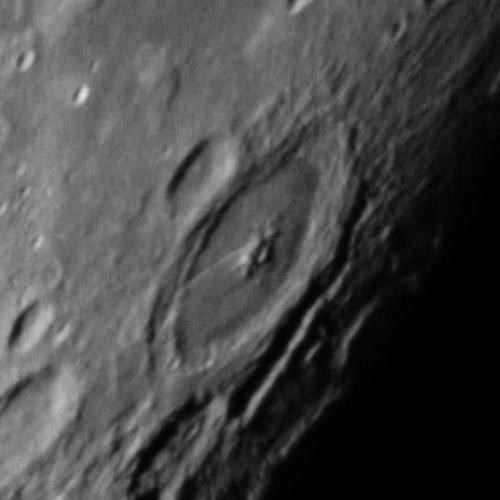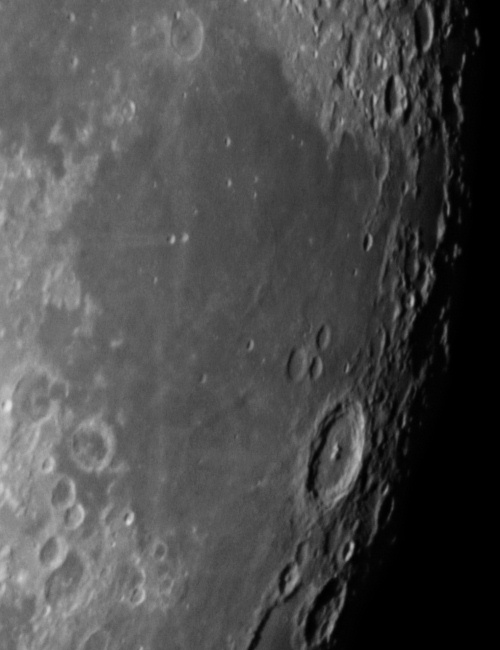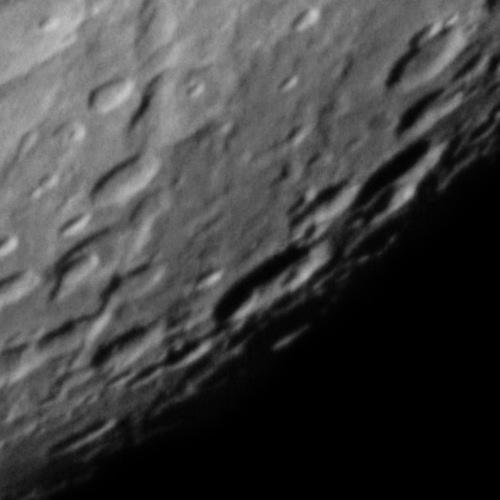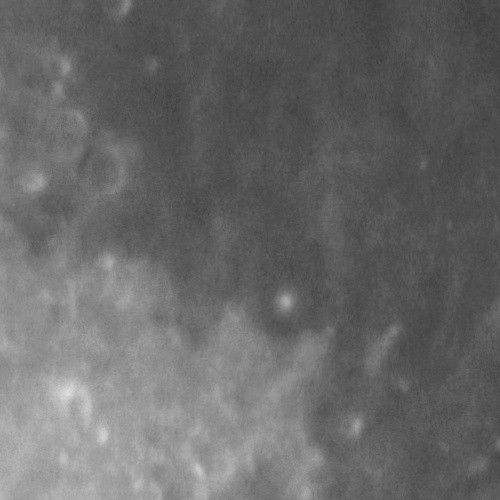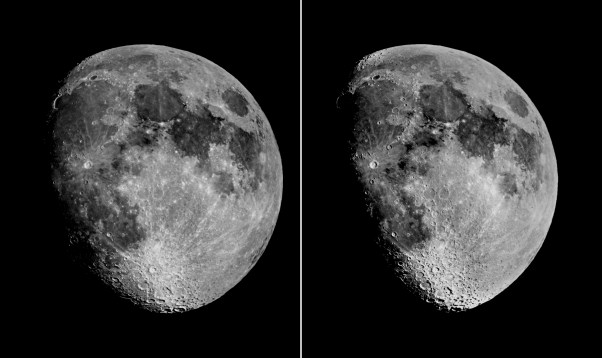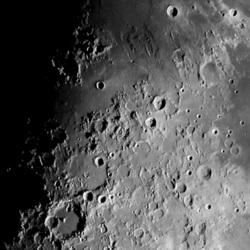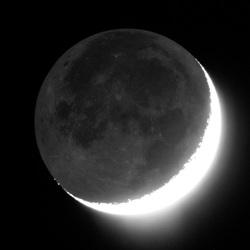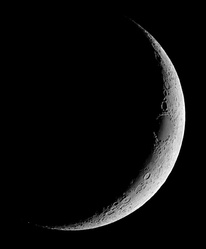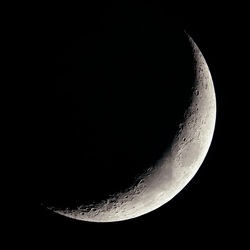The Moon - Luna - Selene
The Moon is an ever-fascinating object in our sky. There is plenty of detail to be seen, and constantly-changing lighting conditions, so I never tire of looking at it. Small telescopes and even binoculars are enough to show the larger craters, while large apertures reveal a wealth of detail upon the ancient surface of our natural satellite.
Total eclipse, 2011-12-10

Canon 30D, with 200 mm f/4 Orestegor & 2x teleconverter; exposures 1/30 - 5 seconds
With this eclipse occurring around midnight, I had hopes for a good night and an extended observing session. My plan was to piggy-back a camera and long lens on the Zeiss, and shoot a timelapse sequence over the period of several hours covering the whole event. At the same time, I would shoot through the Zeiss with that obsolescent thing, photographic film. An APS-C sensor doesn't cover the whole image of the Moon at prime focus, so I would have to revert to a 35mm film camera for the period around totality; I could have shot the Moon in bites, just moving the 'scope in declination to get top & bottom of the disk, but this would have wrecked the timelapse session, so old camera it would have to be.
As it turned out, the weather seemed hopeless and not worth the 2-hour wait after I'd finished work for the night so I abandoned Plan A and went home. At least I could take some static shots if the sky improved, but I wasn't optimistic. However, half an hour into the partial phase, the sky improved enough to see glimpses of the Moon, so I pulled out the gear to see what I could record. The results won't win any prizes, but I could say that I saw something. It would have been nice if the cloud had cooperated into totality, but it thickened up less than a minute before the total phase began, and I saw no more of it.
These shots are passable for the most part, although as the shadow covered more of the Moon and the brightness fell - and especially with the last image which was through fairly thick cloud - the exposure required was too long for a static camera, and some trailing is evident. Here's to next time.
Mike Salway in NSW fared rather better.
Just past Full, 2011-11-12
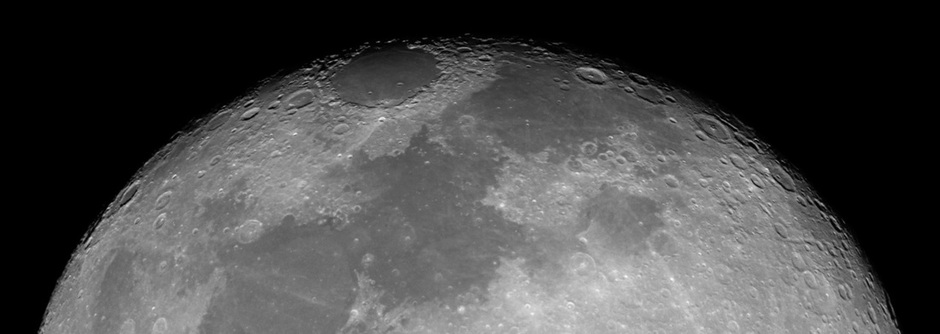
Although the session started out with a rather hazy Moon, it cleared up a bit for a good view of something I don't usually bother with: the Moon near Full. At the time, it was about 30.5 hours past Full, so the terminator was just darkening the eastern edge of the Mare Crisium. Although I usually tell the public that the Moon is best seen around the half phase, there is interesting detail to be found at all phases, if you care to look. For now, I'll let the image speak for itself (I've presented it tipped over, for best viewing on a horizontal screen). Detailed sections below.
The Moon in motion, 2011-11-03
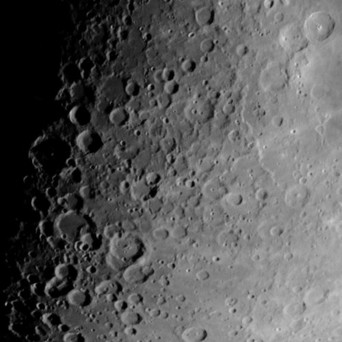
This is a view of the Moon's southern highlands, from Theophilus at top right to Walter at left centre and Pitiscus at bottom centre; the central peak of Walter is just catching the first rays of the rising Sun.
The atmosphere, although very clear, was quite unstable, with a very wobbly image, as the animated image shows. Exposures of 1/125 second were sufficiently short to get a reasonable number of sharp images.
(Click image for animation; 1 MB file)
The atmosphere, although very clear, was quite unstable, with a very wobbly image, as the animated image shows. Exposures of 1/125 second were sufficiently short to get a reasonable number of sharp images.
(Click image for animation; 1 MB file)
Moon, Venus & Mercury, 2011-10-28

The past few days having been fairly cloudy, I wasn't optimistic about being able to catch this picturesque conjunction, so was delighted to see the sky clearing after sunset.
Venus and Mercury are both appearing out of the Sun's glare in the evening sky, after their passage through superior conjunction with the Sun. Earlier today, the Moon occulted Mercury, but even had the sky been clear, it would have been a difficult event to observe. This grouping of 2 planets and our natural satellite was much easier though, with all three plainly visible by 40 minutes after sunset.
At this time, the phase was just 37 hours after New Moon; from the Moon's viewpoint, the Earth would have been almost full, and therefore casting a lot of light back towards the Moon in the form of Earthshine. Sometimes known as the old Moon in the new Moon's arms, this effect lets us see detail in what would otherwise be the dark side of the Moon (not to be confused with the far side, which always faces away from us).
Venus, although the brighter of the 2 planets, is almost at its minimum brightness; it won't reach maximum until April 2012. Mercury, never seen in a dark sky, is now decreasing in brightness as it swings round in its orbit to come between us and the Sun.
This image was taken with a 200mm Meyer Orestegor lens on the 30D; exposures 0.8 & 1 sec, f/8, ISO500. Stack of 9 images, registered on the Moon; Venus & Mercury are therefore slightly trailed, the first and last images being 26 seconds apart.
Venus and Mercury are both appearing out of the Sun's glare in the evening sky, after their passage through superior conjunction with the Sun. Earlier today, the Moon occulted Mercury, but even had the sky been clear, it would have been a difficult event to observe. This grouping of 2 planets and our natural satellite was much easier though, with all three plainly visible by 40 minutes after sunset.
At this time, the phase was just 37 hours after New Moon; from the Moon's viewpoint, the Earth would have been almost full, and therefore casting a lot of light back towards the Moon in the form of Earthshine. Sometimes known as the old Moon in the new Moon's arms, this effect lets us see detail in what would otherwise be the dark side of the Moon (not to be confused with the far side, which always faces away from us).
Venus, although the brighter of the 2 planets, is almost at its minimum brightness; it won't reach maximum until April 2012. Mercury, never seen in a dark sky, is now decreasing in brightness as it swings round in its orbit to come between us and the Sun.
This image was taken with a 200mm Meyer Orestegor lens on the 30D; exposures 0.8 & 1 sec, f/8, ISO500. Stack of 9 images, registered on the Moon; Venus & Mercury are therefore slightly trailed, the first and last images being 26 seconds apart.
Full Moon, 2011-10-12
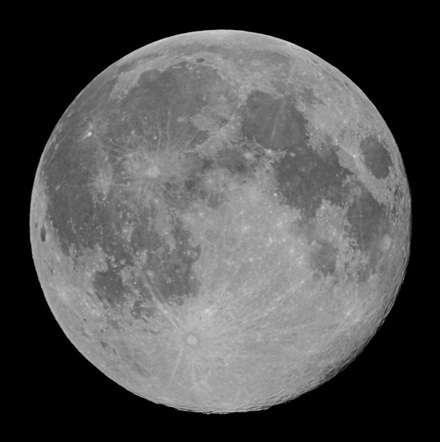
Photographed at prime focus through a 6-inch f/8 Newtonian reflector. This is the green channel of 5 images. The image scale is just about perfect for the APS-C sensor. These images were taken with the telescope tube propped against a couple of chairs; it was neccesary to keep moving the tube every minute or so, but with exposures of 1/350 sec at ISO100, lack of a proper driven mount was no real problem.
I am just getting this 'scope working again after many years of ignoring it, and the collimation is not perfect, so the focus is not even across the frame. Could also be something in the fact that I'm using a fragment of photocopier mirror instead of the proper Newtonian flat, since accidentally throwing out the original some years ago. The 'temporary' substitute does a remarkably good job, but I really ought to replace it. Manana...
Of course, it can't touch the Zeiss for general engineering excellence and solidity, but this rig is at least properly achromatic. Still, I continue to select just the green channel where possible, for minimum noise in the final image.
I am just getting this 'scope working again after many years of ignoring it, and the collimation is not perfect, so the focus is not even across the frame. Could also be something in the fact that I'm using a fragment of photocopier mirror instead of the proper Newtonian flat, since accidentally throwing out the original some years ago. The 'temporary' substitute does a remarkably good job, but I really ought to replace it. Manana...
Of course, it can't touch the Zeiss for general engineering excellence and solidity, but this rig is at least properly achromatic. Still, I continue to select just the green channel where possible, for minimum noise in the final image.
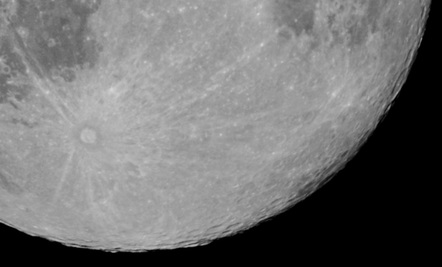
Detail around the south pole. It's actually just about a day past full, but with over 5 degrees of N-S libration, there's a fair bit of shadow visible towards the south polar region. With the flat lighting of Full Moon though, it's not the best time for photography, but if it's there and the sky is clear, you might as well catch it. Besides, I'd like to get as many Moon images as possible, at all phases and degrees of libration, for making 3D stereoscopic pairs. I made an accidental pair many years ago, with images of the waxing gibbous Moon, and would like to make more. It'll be a long project though.
The crater to the left of centre is Tycho - one of the last major impacts on the Moon, around 100 million years ago. It's around 100 km across, but was made by an asteroid only around 5 km in diameter. You get a lot of bang for your buck in asterod impacts.
The crater to the left of centre is Tycho - one of the last major impacts on the Moon, around 100 million years ago. It's around 100 km across, but was made by an asteroid only around 5 km in diameter. You get a lot of bang for your buck in asterod impacts.
Photographed about a month apart, in April & May 1984, there is enough libration between the dates
of these exposures to give a 3D stereo effect. To view the 3D image, just use the 'cross-eye' method;
the central image should give the Moon a rounded appearance.
of these exposures to give a 3D stereo effect. To view the 3D image, just use the 'cross-eye' method;
the central image should give the Moon a rounded appearance.
Miscellaneous recent lunar images, all taken throught the Zeiss 6-inch; some with the 30D at prime focus, some with a 5MP point & shoot digicam, using the afocal method.
